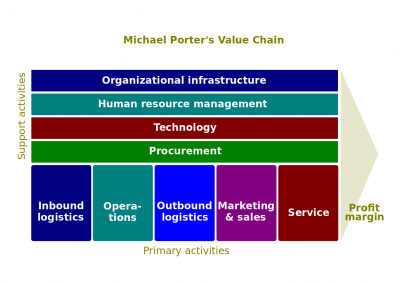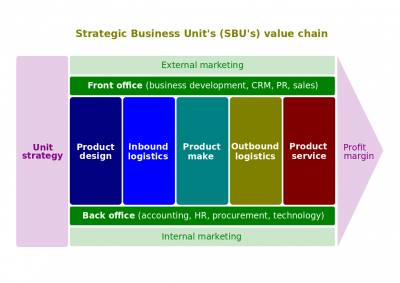Difference between revisions of "Value chain"
(→Applications) |
|||
| (2 intermediate revisions by 2 users not shown) | |||
| Line 18: | Line 18: | ||
According to the [[Strategic Management by David and David (15th edition)]], | According to the [[Strategic Management by David and David (15th edition)]], | ||
:[[Value chain]]. The business of a firm, where total revenues minus total costs of all activities undertaken to develop, produce, and market a product or service yields value. | :[[Value chain]]. The business of a firm, where total revenues minus total costs of all activities undertaken to develop, produce, and market a product or service yields value. | ||
| + | According to the [[HRBoK Guide]], | ||
| + | :[[Value chain]]. Model of how businesses create value. Model of how businesses receive raw materials, add value to the raw materials, and sell finished products to customers. | ||
| + | ==Applications== | ||
| + | ===Service value chain=== | ||
| + | :''Main wikipage: [[ITIL service value chain]]'' | ||
| + | |||
| + | ==See also== | ||
| + | * [[Value chain management]] | ||
[[Category:Marketing Management]][[Category: Quality Management]][[Category: Management]][[Category: Articles]] [[Category: Accounting]][[Category: Strategic Management]] | [[Category:Marketing Management]][[Category: Quality Management]][[Category: Management]][[Category: Articles]] [[Category: Accounting]][[Category: Strategic Management]] | ||
Latest revision as of 23:10, 9 May 2023
A value chain is the entire series of organizational work activities that add value to each step from raw materials to finished product.
Definitions
According to Management by Robbins and Coulter (14th edition),
- Value chain. The entire series of organizational work activities that add value to each step from raw materials to finished product.
According to Marketing Management by Keller and Kotler (15th edition),
- Value chain. A tool for identifying ways to create more customer value.
According to Managing Quality by Foster (6th edition),
- Value chain. A concept developed by Michael Porter that decomposes a firm into its core activities.
According to Cost Accounting by Horngren, Datar, Rajan (14th edition),
- Value chain. The sequence of business functions in which customer usefulness is added to products or services of a company.
According to the Corporate Strategy by Lynch (4th edition),
- Value chain. This identifies where the value is added in an organization and links the process with the main functional parts of the organization. It is used for developing competitive advantage because such chains tend to be unique to an organization.
According to the Marketing Communications by Fill (5th edition),
- Value chain. A term determined by Michael Porter (1985) that refers to the various activities an organization undertakes and links together in order to provide products and services that are perceived by customers to be different and of superior value.
According to Managerial Accounting by Braun, Tietz (5th edition),
- Value chain. The activities that add value to a firm's products and services; includes R&D, design, production or purchases, marketing, distribution, and customer service.
According to the Strategic Management by David and David (15th edition),
- Value chain. The business of a firm, where total revenues minus total costs of all activities undertaken to develop, produce, and market a product or service yields value.
According to the HRBoK Guide,
- Value chain. Model of how businesses create value. Model of how businesses receive raw materials, add value to the raw materials, and sell finished products to customers.
Applications
Service value chain
- Main wikipage: ITIL service value chain

